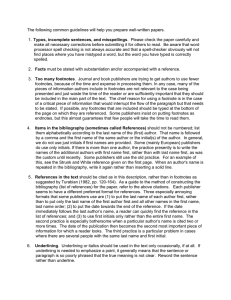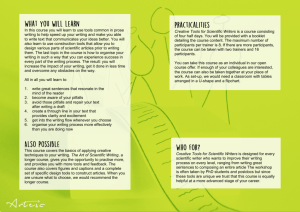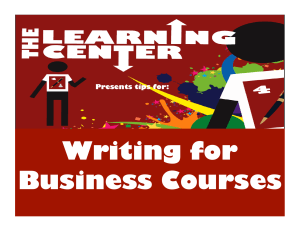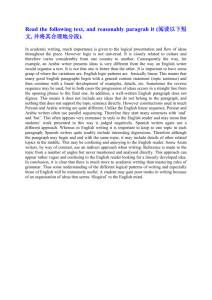11.481J / 1.284J / ESD.192J Analyzing and Accounting for Regional...
advertisement
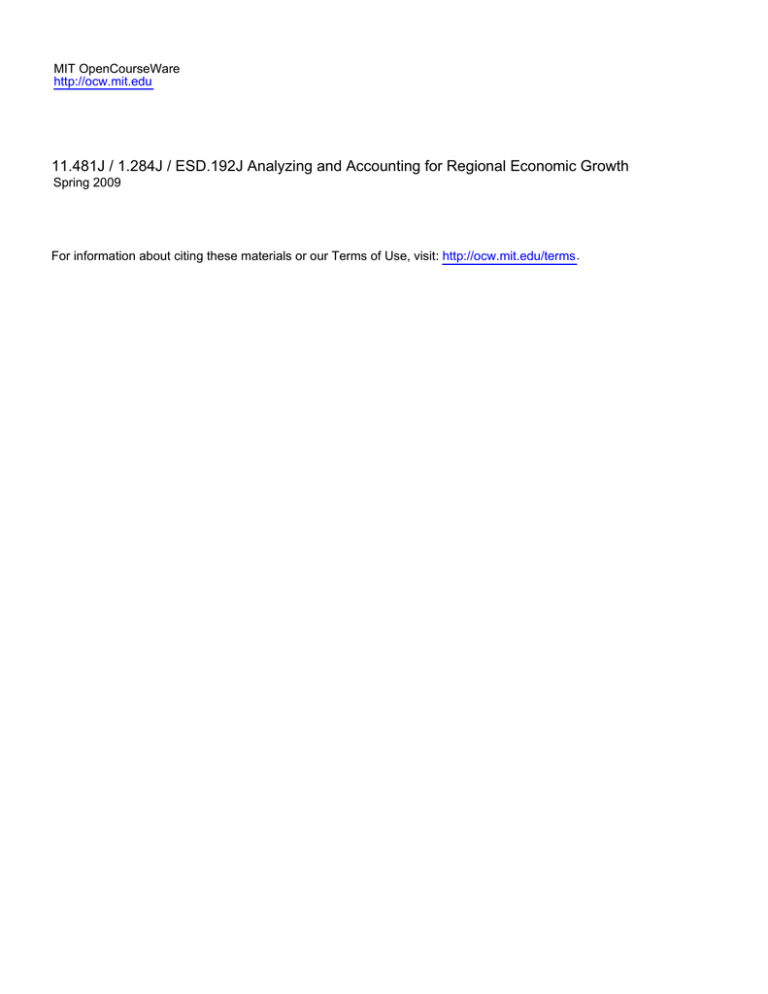
MIT OpenCourseWare http://ocw.mit.edu 11.481J / 1.284J / ESD.192J Analyzing and Accounting for Regional Economic Growth Spring 2009 For information about citing these materials or our Terms of Use, visit: http://ocw.mit.edu/terms. Karen R. Polenske Revised 2007 From 1984, 1988, 1994, 2002 versions SUGGESTIONS FOR WRITERS Please type all drafts and final versions of papers, articles, proposals, etc. One or more of the following references should be used for guidance or for help with grammar, spelling, usage, and paper formats. Bernstein, Theodore M. 1995. The Careful Writer: A Modern Guide to English Usage. New York: Free Press. Chapman, Robert L., ed. 1992. Roget's International Thesaurus. 5th ed. New York: HarperCollins. Fowler, H.W. (Editor) 1983. A Dictionary of Modern English Usage, 2nd edition. Oxford, England: Oxford University Press. Grossman, John (Preface). 1993. The Chicago Manual of Style : The Essential Guide for Writers, Editors, and Publishers (14th Edition). Chicago: Chicago University Press. Miller, Shirley M. 1966. Webster's New World Word Book. New York: The New American Library. no author. 2000. Webster's New Collegiate Dictionary. 9th ed. Springfield, MA: G.S.C. Merriam Co. (Also see their on-line dictionary at http://www.m-w.com/home.htm) Strunk, William Jr., E.B. White, Charles Osgood, and Roger Angell. 2000. The Elements of Style. Boston, MA: Allyn & Bacon. Turabian, Kate L. 1996. A Manual for Writers of Term Papers, Theses, and Dissertations. 6th ed. Chicago, IL: The University of Chicago Press. (This is basically a condensed version of the Chicago Manual of Style cited above.) van Leunen, Mary-Claire. 1986. A Handbook for Scholars. New York: Alfred A. Knopf. Zeisel, Hans. 1985. Say It With Figures. New York: Harper and Row, 6th ed., revised. [NOTE: Later editions of some of these publications are available. Use the latest edition.] _______________ This set of notes was prepared by Karen R. Polenske. A draft was reviewed by Louise Dunlap, Irene S. Raught, and Mark Schuster, who provided helpful suggestions for changes or clarifications. - 2 - The following common guidelines will help you prepare well-written papers. 1. Typos, incomplete sentences, and misspellings. Please check the paper carefully and make all necessary corrections before submitting it for others to read. Be aware that word processor spell checking is not always accurate and that a spell-checker obviously will not find places where you have mistyped a word, but the word you have typed is correctly spelled. 2. Facts must be stated with substantiation and/or accompanied with a reference. 3. Too many footnotes. Journal and book publishers are trying to get authors to use fewer footnotes, because of the time and expense in processing them. In any case, many of the pieces of information authors include in footnotes are not relevant to the case being presented and just waste the time of the reader or are sufficiently important that they should be included in the main part of the text. The chief reason for using a footnote is in the case of a critical piece of information that would interrupt the flow of the paragraph but that needs to be stated. If possible, any footnotes that are included should be typed at the bottom of the page on which they are referenced. Some publishers insist on putting footnotes as endnotes, but this almost guarantees that few people will take the time to read them. 4. Items in the bibliography (sometimes called References) should not be numbered; list them alphabetically according to the last name of the (first) author. That name is followed by a comma and the first name of the same author or the initial(s) of the author. In general, we do not use just initials if first names are provided. Some (mainly European) publishers do use only initials. If there is more than one author, the practice presently is to write the names of the additional authors with first name first, rather than with last name first, as was the custom until recently. Some publishers still use the old practice. For an example of this, see the Strunk and White reference given on the first page. When an author's name is repeated in the bibliography, write it again rather than inserting a solid line. 5. References in the text should be cited as in this description, rather than in footnotes as suggested by Turabian (1982, pp. 120-164). As a guide to the method of constructing the bibliography (list of references) for the paper, refer to the above citations. Each publisher seems to have a different preferred format for references. Three especially annoying formats that some publishers use are (1) to put the last name of each author first, rather than to put only the last name of the first author first and all other names in the first name, last name order; (2) to put the date towards the end of the reference. If the date immediately follows the last author’s name, a reader can quickly find the reference in the list of references; and (3) to use first initials only rather than the entire first name. The second practice is especially bothersome when a particular author’s name is cited two or more times. The date of the publication then becomes the second most important piece of information for which a reader looks. The third practice is a particular problem in cases where there are several people with the same last name and first initial. 6. Underlining. Underlining or italics should be used in the text only occasionally, if at all. If underlining is needed to emphasize a point, it generally means that the sentence or paragraph is so poorly phrased that the true meaning is not clear. Reword the sentence rather than underline. - 3 - 7. Quotes. A reference must be cited for any material that is quoted directly from another source. A general rule is that if the quote is two sentences or less, put the material in quotations and insert it directly in the text, being certain it flows smoothly within the sentence structure. If the quote is more than two sentences, separate the quote from the text by single-spacing and indenting it. Do not use quote marks when indenting the quote, because they are redundant. The reference citation is required in either case. Always introduce and explain each quote to show how and why it is related to the ideas being discussed. Do not include three or four large sections of quoted matter in one paragraph, and do not end a paragraph with a quote. 8. Numbers. Generally, write out small numbers in the text (not in tables), but use Arabic numbers when the figures appear in the same series (for ease of comparison) or when a sentence contains some small numbers and some large ones. In the United States, a number is considered to be small if it is less than 10 and large if it is 10 or greater. Write-The data were available for two to four of the nine regions. Write-In 1947, this figure was 7; in 1958, 103; and in 1963, 138. If the first word of a sentence is a number, the writer may be able to recast the sentence without changing the meaning. If not, write the word rather than the numerical equivalent for the first number. Write-Three hundred classifications were treated. Do not write-300 classifications were treated. Very large numbers that are cumbersome to express in figures or to write out can be expressed in units of millions, billions, trillions, etc. Write-The $10.4 billion difference results from . . . . Do not write-The $10,000,000,000 difference results from . . . . 9. Use of that and which. Please refer to Bernstein for a more detailed explanation of when to use "that" and when to use "which." The general rule is: If a clause is restrictive and the meaning of the sentence would be changed if it is removed, the word "that" should be used. For example, suppose there are three doors (two are closed and one is open) and a window. - 4 - Write: The door that is open is very small. The clause "that is open" is restrictive; if the clause is removed, it may not be clear which of the three doors is meant. On the other hand, if the clause is nonrestrictive and the meaning of the sentence would not be changed if it is removed, the word "which" should be used. The door, which may be open, should be used instead of the window. The clause "which may be open" is nonrestrictive; if the clause is removed, it is still clear that the door should be used rather than the window. Commas are needed for very nonrestrictive clauses, and their use is encouraged for all nonrestrictive clauses. For a few exceptions in the use of the two words, refer to Bernstein (1965, p. 446). 10. Split infinitives. Do not separate the word "to" or other infinitives from the infinitive form of a verb. Write-The handle was used to open the lid quickly. Do not write-The handle was used to quickly open the lid. In rare cases, you may have to disregard this rule. Examples given by Bernstein (1965, p. 426) are: when avoiding the split infinitive produces ambiguity, or is almost impossible, or produces clumsiness or artificiality. 11. Use of dashes. Use a double dash (--), rather than a single dash (-). There are three reasons for this. First, the single dash frequently confuses the reader, as it may be interpreted as a hyphen used either to link two words (refer to point 14) or to separate a long word at the end of a line (however, refer to point 15) instead of being interpreted as a dash. Second, when articles are edited for publication, copy editors will often change single dashes to double dashes, and time is saved by using the double dashes in the first place. Third, if both positive and negative numbers are used in the text, a single dash can be very misleading, as it can be confused with a negative sign. For example: Write-The percentage changes were extremely large--65 percent and 35 percent, respectively-for all except . . . Do not write-The percentage changes were extremely large - 65 percent and 35 percent, respectively - for all except . . . Note that there is no space left on either side of the double dash. If this format is used systematically, there will never be a doubt as to whether a particular number is a negative or just a dash. - 5 - 12. Use of although and while. Use "although" to mean "instead of" and "while" to mean "during the time that." (Bernstein, 1965, p. 476) 13. Starting sentences with "and" or "but." Although authors are increasingly doing so, many prefer not to start sentences with "and" or "but." Also, authors are starting too many sentences with a "however," "therefore," "moreover," etc., when, in fact, they should be connected with the previous sentence by a semicolon, because the thoughts in the two sentences are closely related. 14. Hyphenation of adjectives. The general rule for using hyphens with adjectives is: two or more adjectives should be hyphenated if when they are used alone the true sense of the modification is not clear. Write-The base-year data were obtained from an independent survey in Kenya. Do not write-The base year data were obtained from an independent survey in Kenya. (It is not base data, nor year data, but base-year data that are being described.) 15. Hyphenation at the end of the line. There are three reasons not to hyphenate at the end of a line if it can be avoided. First, most publishers make this request. Second, hyphens at the end of lines, even if properly used, delay a reader. Third, many writers do not know the proper hyphenation, and incorrect hyphenation on their part annoys readers who do know the proper rules and sometimes even leads to misinterpretation of the content. 16. Hyphens for prefixes. Publishers are eliminating the use of hyphens for prefixes; for example, they will now write the word "noncustomary," rather than "non-customary," or "subregional," rather than "sub-regional." They still generally hyphenate words such as "non-negative" and non-nuclear" to separate the two n's. 17. Correct verb. The word "data" is plural; the word "datum" is singular; therefore, use a plural verb with the word "data." Note that there are exceptions. Write-The data are being used by many different agencies. Do not write-The data is being used by many different agencies. 18. Use of active versus passive voice. Writers and readers vary on their preference in this case, but most colleagues in our department now prefer the active voice. Also, whereas in the past, writers used the editorial "we," today most writers will use "I." Note, however, that most international agencies still use the passive voice. If you use "we" or "I," use this form throughout; do not switch from "I" to "we" unless in the one case you are acting alone and in another case a group of you are acting together. In either case, be clear as to who is doing the activity. One reason for not using the passive voice is that some sentences - 6 - are very awkward if it is used; another reason is that the reader may be confused as to who is doing the activity. A few examples follow: Write using "we," not "I," if the group is both constructing and implementing the framework-. . .our group must construct a theoretical framework, but we must also show how the framework is used. . . If you write the sentence using the passive voice, the reader does not know who is constructing the framework, nor if the same person (group) is implementing it-. . .not only must a theoretical framework be constructed, but its use must be shown... do not mix "one" and "I"-. . .not only must one construct a theoretical framework, but I must also show how the framework is used. . . 19. Use of the editorial "we." If you feel more comfortable, you can use the editorial "we" rather than the pronoun "I" in discussing work you have done. 20. Use of because and since. Use the word "because" either as a subordinating conjunction or as an adverb. Use the word "since" as an adverb, preposition, or conjunction. In the case of a conjunction, you may use the word "since," but in economics, a reader may get confused because economists often say "since [some given time]"; thus, a reader will expect "since" to imply "time" rather than a causal relationship. Because the word "since" can take on many meanings, I suggest using the word "because" to avoid ambiguity in subordinate clauses for which either can be used. Write-Because no reason could be found rather than-Since no reason could be found 21. Females and males. Writers in the urban and regional planning field are increasingly using the words "she and he" rather than just "he," the words "him and her" rather than just "him," etc., probably because many women are now professionals in the field, and their voices are being heard. What sounded awkward twenty years ago, no longer does. The use of both, when relevant, does force the reader to remember that women are, say, also applying for jobs, working as bulldozer operators, heading corporations, etc. The strictly male image of past writing begins to fade. (Some writers dislike the use of the "she and he" phrase and put everything in the plural form instead by using "they.") The U.S. Department of Labor has published a list of impersonal words for occupations and names that are to be used to avoid use of words such as fireman, policeman, manhour, etc. The word "laborhour," for example, replaces "manhour;" the phrase "employment training" replaces "manpower training." Writers should be aware of the new terminology and use it. - 7 - On the other hand, when referring to something that was named, say, "manpower training" in the original title, writers must also use that title and not change it to "employment training." 22. Abbreviations. "Set up" any abbreviation the first time you use it in the text to indicate the full term even if it is a frequently used abbreviation. For example, "United Nations (UN). . . the UN will meet in New York." Set up the abbreviations in each chapter of a book, thesis, or dissertation and when a large number of pages, say 15, have intervened since the abbreviation was last used. 23. Passive objects doing things. Papers, tables, books, data, etc., cannot think, determine, etc.; sometimes they can provide or present. Write-Mince and Polachek (1975) determined that the results were insignificant. Do not write-The article by Mince and Polachek (1975) determined that the results were significant. Write either-The tables provided data on income . . . . Or write-Bowles (1968) provided data on income . . . . Always try to be specific as to the person, agency, group, etc. who performed the action. 24. Items in a series. When listing a series of items, some writers do and some do not put a comma before the final item in the series. You will find inserting a comma to be a useful practice in order to avoid any ambiguity. Write-The books, articles, and related materials are on reserve in Rotch. Rather than-The books, articles and related materials are on reserve in Rotch. 25. Comparisons. For comparative words, such as "more" and "less," state more or less than what. Write-Korean laborers can produce more products than U.S. laborers can. The following is ambiguous-Korean laborers can produce more products. - 8 - 26. Use of the word "address." Use a specific word, rather than the vague word "address." You "address" a letter, but you "discuss," "analyze," "solve," "answer," etc. an issue or a question. British writers tend to use the word address as a substitute for analyze, but I prefer using a specific verb. 27. Tables (refer to Suggestions for Tables). Set up tables neatly, using the basic format given by Turabian (1973, pp. 166-171). The exception is that you do not need to use the vertical lines; only use the horizontal ones she suggests. Be certain to include units of measure, year, country, etc., to which the data refer and the source(s) of the data. You should not carry percentages to more than 1 decimal. Type all related numbers with the same number of significant digits. (For example, do not omit decimals for some numbers and use one, two, three, or more, for others.) These are guidelines for some of the more common issues that arise in writing in the economics, urban studies, and planning fields. Writers tend to repeat the same errors, most often in spelling, grammar, and usage. If you are careful to check your drafts, papers, etc., and correct such errors, people who are asked to read your writing can concentrate on the substance, rather than the writing, and both parties will benefit.
